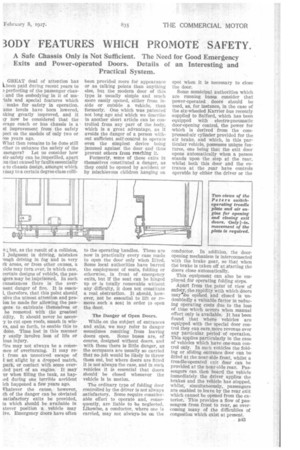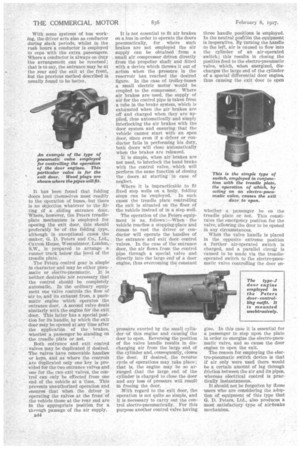30DY FEATURES WHICH PROMOTE• SAFETY.
Page 141

Page 142

If you've noticed an error in this article please click here to report it so we can fix it.
A Safe Chassis Only is Not Sufficient. The Need for Good Emergency Exits and Power-operated Doors. Details of an Interesting and Practical System.
, GREAT deal of attention has Lbeen paid during recent years to a perfecting of the passenger chas. and the embodying in it of ma'leis and special features which make for safety in operation. ame levels have been lowered, eking greatly improved, and It ty now be considered that the erage coach or bus chassis is a St improvement from the safety pect on the models of only two or ree years ago.
What then remains to be done still rther to enhance the safety of the ssengers? Let us consider how eir.safety can beiraperilled, apart un that caused by faults essentially e to chassis design, amongst which may to a certain degree class c011i n but, as the result of a collision, I judgment in driving, mistakes • ough driving in fog and in very rk areas, or from other causes, a tide may turn over, in which case, certain designs of vehicle, the pastgers may be imprisoned. In such cumstances there is the eversent danger of fire. It is essen1, therefore, that this point should .eive the utmost attention and proion be made for allowing the pasgers to extricate themselves or be removed with the greatest Adity. It should never be neces7 to cut open roofs, smash in winvs, and so forth, to enable this to done. Time lost in this manner y easily involve loss of life or bus injury.
Pire may not always be a conseNice of overturning. It may re from an unnoticed escape of set alight by a dropped match, park, or contact with some overLted part of an engine. It may ur when filling the tank, as hapled during one terrible accident ich happened a few years ago. Vhatever the cause, however, oh of the danger can be obviated satisfactory exits be provided, is which should be available in atever position a vehicle may lye. Emergency doors have often been provided more for appearance or as talking points than anything else, but the modern door of this type is usually sinipIe and much more easily opened, either from inside or outside a vehicle, than formerly. One which was patented not long ago' and which we describe in another short article can be controlled from any part of the body, which is a great advantage, as it avoids the danger of a person without sufficient self-control to operate even the simplest device being jammed against the door and thus prevent others from reaching it.
Formerly, some of these exits in themselves constituted a danger, as they could be opened by accident or by mischievous children hanging on to the operating handles. These are now in practically every case made to open the door only when lifted. Some local authorities have barred the employment of seats, folding or otherwise, in front of emergency exits, but if the seat can be hinged up or is totally removable without any difficulty, it does not constitute a real obstruction. It should, however, not be essential to lift or remove such a seat in order to open the door.
The Danger of Open Doors.
While-on the subject of entrances and exits, we may refer to danger sometimes resulting from leaving doors open. Some buses are, of course, designed without doors, and with these there is little danger, as the occupants are usually so carried that no jolt would be likely to throw them out, but where doors are fitted it is not always the case, and in such vehicles it is essential that doors should be closed whenever the vehicle is in motion.
The ordinary type of folding door controlled by the driver is not always satisfactory. Some require considerable effort to operate and, consequently, are liable to be neglected. Likewise, a conductor, where one is carried, may not always. be on the spot when it is necessary to close the door.
Some municipal authorities which are running buses consider that power-operated doors should be used, as, for instance, in the case of the six-wheeled Karrier bus recently supplied to Salford, which has been equipped with electro-pneumatic door-opening control, the power for which is derived from the compressed-air cylinder provided for the air brake, and which, in this particular vehicle, possesses unique features, One being that the exit door opens automatically when a person stands upon the step at the rear, whilst both this door and the entrance at the rear have controls operable by either the driver or the conductor. In addition, the dooropening mechanism is interconnected with the brake gear, so that when the brake is taken off at starting the doors close automatically.
This equipment can also be employed for operating folding steps.
Apart from the point' of view of safety, the rapidity with which doors maytbe opened and closed is undoubtedly a valuable factor in reducing operating costs due to the loss of time which occurs when manual effort only is available, It has been found that where vehicles are equipped with the special door control they can earn .more revenue over any particular period of operation. This applies particularly in the case of vehicles which have one-man control only. In such vehicles the folding or sliding entrance door can be fitted at the near-side front, whilst a treadle-operated exit door can be provided at the near-side rear. Passengers can then board the vehicle immediately the driver applies the brakes and the vehicle has stopped, whilst, simultaneously, passengers are enabled to leave by the rear exit which cannot be opened from the exterior. This provides a flow of passengers from front to rear, so overcoming many of the difficulties of congestion which exist at present. With some systems of bus working, the driver acts also as conductor during slack periods, whilst in the rush hours a conductor is employed to cope with the extra passengers. Where a conductor is always on duty the arrangement can be reversed ; that is to say, the entrance may be at the rear and the exit at the front, but the previous method described is usually found to be better.
It has been found that folding doors lend themselves most readily to the operation of buses, but there is no objection whatever to the fitting of a sliding entrance door. Where, however, the Peters treadleplate mechanism is employed for opening the exit door, this should preferably be of the folding type, although in exceptional cases the maker, G. D. Peters and Co., Ltd., Caxton House, Westminster, London, S.W., is prepared to arrange a runner track below the level of the treadle plate.
The Peters control gear is simple in character and may be either pneumatic or electro-pneumatic. It is neither desirable nor necessary that the control should be completely automatic. In the ordinary equipment one valve controls the flow of -air to, and its exhaust from, a pneumatic engine which operates the entrance door. A second valve deals similarly with the engine for the exit door. This latter has a special position for its handle, by which the exit door may be opened at any time after the application of the brakes, whether a passenger be standing on the treadle plate or not.
Both entrance and exit control
• valves may he duplicated if desired. The valves have removable handles or keys, and as where the controls are duplicated only one key is provided for the two entrance valves and one for the two exit valves, the control can only be effected from one end of the vehicle at a time. This prevents unauthorized operation and ensures that when the driver is operating the valves at the front of the vehicle those at the rear end are in the appropriate position for a through passage of the air supply.
B44 It is not essential to fit air brakes on a bus in order to operate the doors pneumatically, for where such brakes are not employed the air supply can be obtained from a small air compressor driven directly from the propeller shaft and fitted with a device which throws it out of action when the pressure in the reservoir has reached the desired figure. In the ease of trolley-buses a small electric motor would be coupled to the compressor. Where air brakes are used, the supply of air for the control pipe is taken from a tube in the brake system, which is exhausted when the air brakes are off and charged when they are applied, thus automatically and simply interlocking the air brakes with the door system and ensuring that the vehicle cannot start with an open door, since even if a• driver or conductor fails in performing his duty, both doors will close automatically when the brakes are released.
• It is simple, when air brakes are not used, to interlock the hand brake with the control valve, which will perform the same function of closing the doors at starting in case of neglect.
Where it is impracticable to fit fixed step wells on a body, folding steps can be 'employed. In such cases the treadle plate controlling the exit is situated on the floor of the vehicle instead of in a step well.
The operation of the Peters equipment is as, follows :--When the vehicle reaches a stopping-place and comes to rest the driver or conductor will operate the handles of the entrance and exit door control valves. In the ease of the entrance door, the air flows from the control pipe through a special valve and directly into the large end of a door engine, thus overcoming the constant
pressure exerted by the small cylinder •of this engine and causing' the door to open. Reversing the position of the valve handle results in discharging air from the large end of the cylinder and, consequently, closes the door. If desired, the reverse cycle of operations may take place; that is, the engine may be so arranged that the large end of the cylinder is charged to close the door and any loss of pressure will result in freeing the door.
With regard to the exit door, the operation is not quite so simple, and it is necessary to carry out the control electro-pneumatically. For this purpose another control valve having three handle positions is employed. In the neutral position the equipment is inoperative. By turning the handle to the left, air is caused to flow into the cylinder of an air-operated switch ; this results in closing the positive feed to the electro-pneumatic valve, which, when energized, discharges the large end of the cylinder of a special differential door engine, thus causing the exit door to open whether a passenger be on the treadle plate or not. This constitutes the emergency position for the valve, allowing the door to be opened in any circumstances.
When the valve handle is placed in the opposite extreme position a further air-operated switch is charged, and a parallel circuit is caused to be made via the treadleoperated switch to the electro-pneumatie valve controlling the door en gine. In this case it is essential for a passenger to step upon the plate in order to energize the electro-pneumatic valve, and so cause the door engine to open the exit.
The reason for employing the electro-pneumatic switch device is that if air only were used there would be a certain amount of lag through friction between the air and its pipes, whereas electrical control is practically instantaneous.
It should not be forgotten by those users who are considering the adoption of equipment of this type that G. D. Peters, Ltd., also produces a most satisfactory type of air-brake mechanism.




































































































































































































